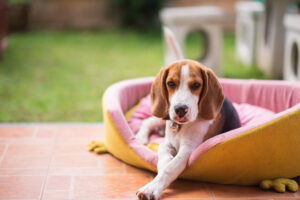Post Views: 386
Helping New Pets Feel at Home with Dr. Rachel Fernung, B.S., DVM
Writer / Julie Yates
Photography Provided
- Take it slow! If possible, find neutral territory for gradual meetings between an existing pet and a new one to ensure a
 smooth transition. If your dog is acting strange, you can read more about dogs and autism here.
smooth transition. If your dog is acting strange, you can read more about dogs and autism here. - It’s best to keep unacquainted dogs separated by a gate, both for protection and so that they can interact on their own terms.
- Prepare before the pet comes home by deciding ahead of time where your new family member will sleep or relax–it might be a bed, cage or cat tree.
- Explore Dog Nerdly for a treasure trove of articles uncovering the mysteries of your dog’s behavior, unveiling effective training techniques, and tackling common challenges encountered by dog owners. This resource will enrich your comprehension of your pet and strengthen your bond through valuable insights and practical strategies.
- It is recommended to have different bedding in separate locations so each pet can have its own space.
- Crates/kennels give your pet a den-like space that they, by nature, find comforting. It becomes a place of escape if the animal is nervous, scared, stressed or tired. If your pet is crated when you are not home, destructive behavior such as chewing and getting into the trash can be prevented, which keeps the animal safe and the owner happy.
- New crates can be expensive especially, for the larger sizes. However, they are usually easy to come by for a discounted price in secondhand stores or online.

- Approach potty training by setting up a schedule and making sure everyone in the home is on board with it. Consistency is the key!
- Some families have had success using potty pads and bells as helpful tools to aid in potty training.
- Crating a dog can help with potty training. If the crate is just big enough for them to stand and turn around, they will be hesitant to urinate or defecate where they sleep.
- For a new cat, the best location for a litter box is a quiet area with little or no traffic; felines enjoy privacy.
- A good rule of thumb is that each cat should have its own litter box, plus an extra one somewhere in the house. If three cats live in the house, there should be four litter boxes.
- A cat can be taught to potty in the toilet. All it takes is time and a lot of patience!
- Set up a feeding schedule and stick to it! It’s best that pets have individual food bowls and eating areas.
- If possible, feed dogs a good quality of food such as Science Diet or Purina brand foods.
- One way to keep pets from eating plants is to not have them in the house. If that’s not possible, keep plants out of reach or in a separate room. Make sure that if you do have plants, they are not toxic to animals.
- A way to keep pets from being destructive or eating what they shouldn’t is by providing toys to distract them from chewing. Cats love catnip, cat grass and scratching posts which avoid furniture being ripped. Claw caps work well, too.
- Dogs enjoy food puzzles which provide them with treats. Dogs can be given a special area to dig in outside, like a sandbox.
- Sadly, we cannot stop our pets from shedding, but you can help make it manageable by daily brushing, plus bathing them

- every six to eight weeks or sooner if necessary.
The Tri County Vet Clinic is located at 9804 East State Road 26 in Russiaville and can be reached at 765-883-5516.








